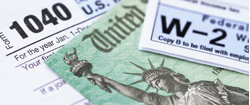Tax season can be stressful, especially if you’re approaching the deadline and haven’t filed your taxes yet. If you’re feeling the pressure of last-minute tax filing, don’t worry! We’ve got some expert tips to help you file quickly, avoid penalties, and make the process as smooth as possible. Read on for last-minute tax filing tips that can help you beat the clock and file with ease.
Understanding Tax Deadlines
Tax deadlines are crucial dates that taxpayers must adhere to when filing their tax returns. For most calendar year filers, the due date is typically April 15. However, if this date falls on a Saturday, Sunday, or legal holiday, the deadline is moved to the next business day. Understanding these deadlines is essential to avoid penalties and interest on unpaid taxes. Missing the due date can result in late filing penalties, which can add up quickly. Therefore, it’s important to mark your calendar and ensure your tax return is filed on time.
Gather All Necessary Documents (Quick Checklist)
One of the most important steps in filing your taxes, especially when you’re short on time, is gathering all the necessary documents. Having everything organized in one place will save you time and reduce errors. Here’s a quick checklist to ensure you have everything you need:
- W-2 forms from your employer
- 1099 forms if you’re a freelancer or contractor
- Social Security Number (SSN) or Individual Taxpayer Identification Number (ITIN)
- Bank account info for direct deposit of any refund
- Receipts or records for deductible expenses (e.g., student loan interest, charitable donations)
- Health insurance info (Form 1095-A, 1095-B, or 1095-C)
If you’re missing any of these forms, don’t panic! Contact your employer or financial institution to get them as soon as possible. If you’re unable to get them in time, you can still file using the information you do have, and update your return later if needed.
Tip: Keep all your documents organized in one place—this will speed up the process, especially when filing online.
Use Tax Software to Streamline the Filing Process
When you’re running out of time, the best way to file your taxes quickly and accurately is by using electronic filing through tax software. ezTaxReturn is a great option for those looking to file online, as it guides you step-by-step through the process, ensuring nothing is missed. Filing online with tax software also reduces the chance of errors, which can delay your refund or even lead to penalties.
Tax software makes it easy to input your information, calculate your taxes, and submit your return—all in one sitting. The best part? You can file anytime, anywhere, as long as you have an internet connection.
If you plan to use the same tax software you did last year, you can save time on your last-minute tax filing by using prior-year import. With the click of a button, last year’s information will be automatically transferred into this year’s return bringing you one step closer to your refund.
Tip: Online tax filing with ezTaxReturn is designed to be quick and easy—so you can finish your taxes in as little as 30 minutes.
File for an Extension (If Necessary)
If you know you won’t make the deadline but still want to avoid penalties, consider filing for a tax extension. Extensions give you an additional six months to file your return, but it’s important to remember that an extension doesn’t give you extra time to pay. The IRS expects you to pay any taxes owed by the original deadline, April 15th.
If you need more time to gather documents or complete your return, filing an extension can take the pressure off. However, if you owe taxes, make sure to estimate and pay any amount due to avoid interest and penalties.
Double-Check for Deductions and Credits You May Have Missed
Even when you’re filing last-minute, don’t skip the deductions and credits that could lower your tax bill. Last-minute filers often overlook common deductions like:
- Student loan interest (if you’re paying back loans)
- Charitable donations (keep receipts for any donations made)
- Home office expenses (for freelancers or remote workers)
- Retirement account contributions (if applicable)
Tax credits like the Earned Income Tax Credit (EITC) and Child Tax Credit can also significantly reduce your tax bill. Make sure you review your tax documents to see if you qualify for any of these credits or deductions.
Tip: ezTaxReturn helps you identify available deductions and credits to ensure you’re maximizing your refund.
Pay What You Owe to Avoid Penalties and Interest
One of the most critical aspects of filing taxes is ensuring you pay any amount owed by the deadline to avoid penalties and interest. The IRS imposes a late payment penalty of 0.5% per month on any unpaid balance, which can increase to 25%. Additionally, you may face failure to pay penalties if you do not pay on time. On top of that, interest is charged on any unpaid tax balance, which compounds daily.
If you can’t afford to pay the full amount, the IRS offers options like installment plans, or you can use a credit card to pay. The key is to pay as much as you can by the deadline to minimize penalties.
Tip: If you owe taxes, make sure to pay by April 15th. ezTaxReturn provides secure payment options to help you avoid penalties.
Refund and Payment Timing
If you’re expecting a refund, you can typically receive it within a few weeks of filing your tax return, especially if you opt for direct deposit into your bank account. On the other hand, if you owe money, it’s crucial to pay your taxes by the due date to avoid penalties and interest. To prevent a large tax bill at the end of the year, consider making estimated tax payments throughout the year. This can help you manage your tax liability and avoid any surprises come tax time.
Don’t Forget to E-file and Confirm Submission
The IRS recommends you file electronically, especially when filing at the last minute. E-filing is faster, more accurate, and allows you to receive immediate confirmation that your return has been successfully submitted. If you’re filing online, make sure to double-check your submission to avoid mistakes that could delay your refund or cause issues later. Before clicking “Submit”, make sure you:
- Entered your Social Security Number (SSN) correctly.
- Spelled your name right.
- Reported all your income.
- Provided the correct banking information, including your bank account details.
It may seem silly, but these kinds of errors happen more often than you think.
Tip: After e-filing with ezTaxReturn, you’ll receive an email confirmation of your submission. This ensures you’re all set before the deadline.
Seek Help If You’re Feeling Overwhelmed
Filing taxes at the last minute can be overwhelming, especially if you’re unsure about deductions, credits, or how to file. If you’re feeling stressed, don’t hesitate to seek help. ezTaxReturn’s support service is available to answer any questions you might have.
Tip: Don’t be afraid to ask for help! ezTaxReturn provides customer support to ensure you file correctly and on time. Contact us!
Business Tax Considerations
Businesses have unique tax considerations that must be taken into account when filing their tax returns. For businesses operating on a fiscal year basis, the due date is the 15th day of the third or fourth month after the close of their fiscal year. It’s important for businesses to make estimated tax payments throughout the year to avoid penalties and interest. Additionally, businesses must file specific forms and schedules, such as Form 1120 for C corporations and Form 1120S for S corporations. Keeping track of these requirements ensures that your business remains compliant and avoids any unnecessary penalties.
Post-Filing To-Do’s
After filing your tax return, there are several important tasks to consider to ensure everything is in order:
- Review your tax return: Double-check your tax return for accuracy and completeness. If you find any errors or omissions, you may need to file an amended return using Form 1040-X.
- Pay any remaining balance: If you owe taxes, make sure to pay the remaining balance by the due date to avoid additional penalties and interest.
- Set up a payment plan: If you cannot pay your tax bill in full, consider setting up a payment plan with the IRS. You can use Form 9465 to request an installment agreement.
- Update your withholding: If you received a large refund or owed a significant amount of taxes, you may need to adjust your withholding to avoid similar issues in the future. Use the W-4 calculator to determine the correct withholding amount.
- Update your address: Ensure that your address on file with the IRS is current. This is crucial for maintaining accurate records and ensuring that all tax-related communications reach you.
- Keep accurate records: Keep accurate records of your tax-related documents, including receipts, invoices, and bank statements, in case of an audit or future tax-related issues.
By completing these post-filing tasks, you can ensure a smooth tax filing process and avoid any potential issues with the IRS. Taking these steps will help you stay organized and prepared for the next tax season.
Take Action Now to Avoid Last-Minute Stress
With only a few days left to file, it’s time to act quickly and make sure your taxes are filed correctly. By following these last-minute tax filing tips, you can minimize stress, avoid penalties, and ensure a smooth filing experience. Timely filing is crucial to avoid failure to file penalties and the financial repercussions of neglecting tax obligations.
Remember, ezTaxReturn makes filing easy, fast, and secure, so you can file your taxes with confidence—even at the last minute. Don’t wait—start filing now and beat the deadline!
FAQs About Last-Minute Tax Filing:
Can I file taxes after the deadline?
You can still file after the deadline, but you may face penalties and interest if you owe taxes. If you need more time to file, consider requesting an extension.
What happens if I miss the tax filing deadline?
If you miss the deadline and don’t file for an extension, you could be hit with late filing penalties. Make sure to file as soon as possible to avoid further penalties.
How can I file taxes quickly online?
The easiest way to file taxes quickly is by using tax software like ezTaxReturn. It allows you to file from home, get immediate confirmation, and finish in under 30 minutes.
Why is it important to file federal income tax returns?
Filing federal income tax returns is crucial to avoid penalties and interest. Understanding deadlines and extensions for federal income tax is essential for both individual and business taxpayers to ensure compliance and avoid unnecessary charges.
The articles and content published on this blog are provided for informational purposes only. The information presented is not intended to be, and should not be taken as, legal, financial, or professional advice. Readers are advised to seek appropriate professional guidance and conduct their own due diligence before making any decisions based on the information provided.




